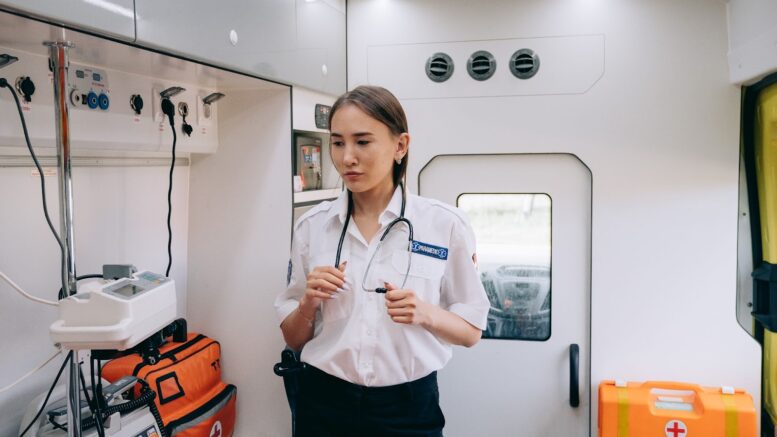Using a third-party service to handle patient transfers is not a new practice in the US. However, with most American healthcare providers struggling to cope with the ongoing labor shortage, patient transfers are now increasingly being handled by professional transport services rather than hospitals’ in-house ambulance teams.
Interestingly, those that choose a professional hospital patient transfer solution enjoy more than just labor-saving benefits. In many cases, they also see a boost in operational efficiency and patient outcomes, making transport services worth considering even for hospitals and health facilities that may not have staffing issues. Let’s delve into the advantages of using a third-party transport provider and explore how care providers get these benefits:
1) Better Efficiency
Unlike healthcare providers, professional transport services specialize in patient transfers. This expertise allows them to optimize the entire transfer process, reducing delays and improving overall efficiency. Moreover, many of these transport service providers operate in multiple service areas, giving them diverse experiences with which to tailor their services. In contrast, in-house ambulance teams rarely have the operational scale or varied experience to match the efficiency of specialized transport services.
Most importantly, professional transporters can guarantee specific service levels. Most transport services have well-established systems for managing different transfer scenarios, allowing them to spend less time waiting and doing paperwork and more time serving patients. From efficient scheduling and dispatching of appropriately equipped vehicles to coordinating with healthcare facilities, they ensure smooth transitions for patients, minimizing waiting times and disruptions in care.
2) Matches Patients to Needed Transport Options
As alluded to earlier, every transfer is different because each patient has unique medical needs. Choosing the right transport option is crucial not only to guarantee a specific patient’s safety and well-being during the transfer but also to ensure that appropriate transportation options are available for other patients.
To accurately match patients to the most suitable transport options, patient transport solution providers may employ advanced technology and sophisticated algorithms. They consider factors such as a patient’s medical condition, mobility requirements, and equipment needs to determine whether non-emergency medical transportation (NEMT), wheelchair-accessible vehicles, or critical care transport is the best fit for the situation.

3) Lower Costs
In-house patient transfers can incur substantial expenses for healthcare facilities, costs that can include vehicle maintenance, staff training, and administrative overheads. Because vehicle pools and driver training are just among the many things a hospital needs to prioritize, the cost optimization for in-house ambulance teams is sometimes not ideal.
By outsourcing patient transfers to professional providers, healthcare facilities can benefit from their partner’s economies of scale and access to cost-effective solutions. Unlike in-house transport options, specialized transport providers have established networks and dedicated resources, allowing them to offer services at competitive rates. Additionally, outsourcing minimizes the need for in-house transport teams, freeing up resources and reducing financial burdens.
4) Data-Driven Reporting
Accurate data is essential for identifying areas of improvement, enhancing patient care, and optimizing transport logistics. Professional transport providers leverage data-driven reporting tools to analyze key performance indicators (KPIs), including transfer times, patient satisfaction, and incident rates. By closely monitoring these metrics, transport services, and healthcare providers can identify trends, make informed decisions, and implement process improvements to enhance the overall patient transfer experience.
5) Enhanced Safety and Training
Patient transfers come with inherent risks, particularly for critically ill or medically fragile individuals. Additionally, some modes of transport, such as helicopters, carry additional risks for both the patient and the individuals involved in the transfer.
Due to their specialization, professional transport providers can better prioritize safety and invest in comprehensive training for their staff. Transport personnel undergo specialized training in medical procedures, emergency protocols, and proper vehicle handling to address various patient needs and ensure safe transportation. By entrusting patient transfers to well-trained professionals, healthcare providers can mitigate risks and provide a higher level of care.
6) 24/7 Availability and Reliability
Medical emergencies and patient transfers can occur at any time, necessitating round-the-clock availability and reliability. Unfortunately, with the current EMS labor shortage in the United States, it’s getting more and more difficult for hospitals to ensure seamless patient transfers without the support of professional transport providers and patient transport solutions.
Professional transport providers can plug service gaps and offer 24/7 availability to cater to the unpredictable nature of healthcare needs. Compared to individual healthcare providers and hospitals, professional transport services are better able to maintain a fleet of vehicles, skilled personnel, and efficient scheduling systems to promptly respond to transfer requests at all hours. This reliability ensures continuity of care, prevents delays in treatment, and ultimately contributes to better patient outcomes.
Specialized transport services offer the operational scale, focus, and experience that healthcare providers need to optimize their operations and improve the quality of patient care in trying times. By entrusting patient transfers to these experienced professionals, healthcare facilities and hospitals can directly address labor shortages, enhance patient care, and ensure smooth transitions for patients throughout their healthcare journey.
